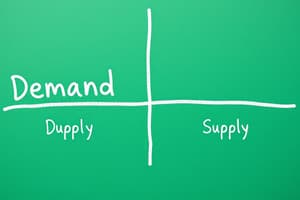Podcast
Questions and Answers
What does the term 'elasticity' in microeconomics primarily measure?
What does the term 'elasticity' in microeconomics primarily measure?
- The responsiveness of quantity demanded or supplied to price changes (correct)
- The total revenue generated from selling a product
- The relationship between consumer income and demand
- The total quantity of goods available in the market
At what point do demand and supply meet to determine the market price?
At what point do demand and supply meet to determine the market price?
- Surplus
- Equilibrium (correct)
- Consumer surplus
- Shortage
Which scenario depicts a situation of inelastic demand?
Which scenario depicts a situation of inelastic demand?
- A 10% increase in price results in a 15% decrease in quantity demanded
- A 5% increase in price results in a 5% increase in quantity demanded
- A 20% decrease in price results in a 30% increase in quantity demanded
- A 10% increase in price results in a 5% decrease in quantity demanded (correct)
What is true about the price elasticity of demand when it’s classified as elastic?
What is true about the price elasticity of demand when it’s classified as elastic?
What is the primary focus of microeconomics compared to macroeconomics?
What is the primary focus of microeconomics compared to macroeconomics?
Flashcards are hidden until you start studying
Study Notes
Microeconomics
-
Definition:
- Study of individual consumers and businesses and how they make decisions regarding resource allocation.
-
Key Concepts:
-
Demand and Supply:
- Demand: Quantity of a good or service consumers are willing to purchase at various prices.
- Supply: Quantity of a good or service producers are willing to sell at various prices.
- Equilibrium: Point where demand equals supply, determining market price.
-
Elasticity:
- Measures responsiveness of quantity demanded or supplied to price changes.
- Types:
- Price Elasticity of Demand: Sensitivity of quantity demanded to price changes; elastic (>1) or inelastic (<1).
- Income Elasticity of Demand: Sensitivity of demand to changes in consumer income.
- Cross-Price Elasticity: Measures how the quantity demanded of one good responds to the price change of another good.
-
Consumer Behavior:
- Utility: Satisfaction gained from consuming a good or service.
- Marginal Utility: Additional satisfaction from consuming one more unit; influences consumer choice.
- Budget Constraint: Limits consumers face based on income and prices of goods.
-
Production and Costs:
- Production Function: Relationship between inputs used in production and the resulting output.
- Short-Run vs. Long-Run:
- Short-run: At least one input is fixed.
- Long-run: All inputs can be varied.
- Costs:
- Fixed Costs: Costs that do not change with output level.
- Variable Costs: Costs that vary with production level.
- Total Cost, Average Cost, and Marginal Cost: Key metrics for firms in decision-making.
-
Market Structures:
- Perfect Competition: Many firms, homogeneous products, free entry and exit.
- Monopoly: Single seller, unique product, high barriers to entry.
- Oligopoly: Few firms, potential for collusion, products may be identical or differentiated.
- Monopolistic Competition: Many firms, differentiated products, some market power.
-
Market Failures:
- Situations where market outcomes are not efficient.
- Causes include:
- Externalities: Costs or benefits affecting third parties (e.g., pollution).
- Public Goods: Non-excludable and non-rivalrous goods (e.g., national defense).
- Information Asymmetry: One party has more information than another (e.g., used car market).
-
-
Government Intervention:
- Taxes and Subsidies: Tools to correct market failures and influence behavior.
- Regulation: Rules set by government to control market practices (e.g., price controls, antitrust laws).
-
Welfare Economics:
- Study of how economic activities affect overall social welfare.
- Concepts of Consumer Surplus and Producer Surplus as measures of economic welfare.
Microeconomics Overview
- Focuses on individual consumers and businesses, analyzing their decision-making regarding resource allocation.
Demand and Supply
- Demand: Refers to the amount of a good or service that consumers are willing to buy at different price levels.
- Supply: Represents the amount of a good or service that producers are willing to offer for sale at various prices.
- Equilibrium: The market condition where the quantity demanded equals the quantity supplied, establishing the market price.
Elasticity
- Elasticity quantifies how much the quantity demanded or supplied changes in response to price fluctuations.
- Types:
- Price Elasticity of Demand: Indicates the degree of change in quantity demanded in relation to a change in price. Classifications include:
- Elastic Demand: Occurs when elasticity is greater than 1, indicating a proportionately larger change in quantity demanded.
- Inelastic Demand: Occurs when elasticity is less than 1, showing a lesser change in quantity demanded despite price changes.
- Price Elasticity of Demand: Indicates the degree of change in quantity demanded in relation to a change in price. Classifications include:
Studying That Suits You
Use AI to generate personalized quizzes and flashcards to suit your learning preferences.




